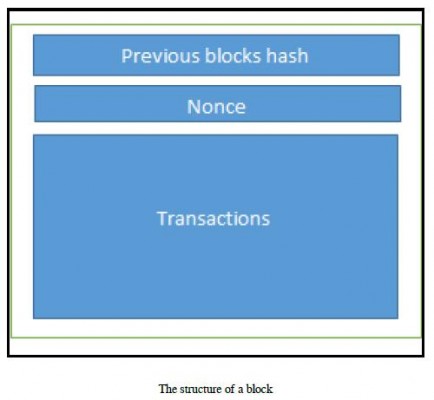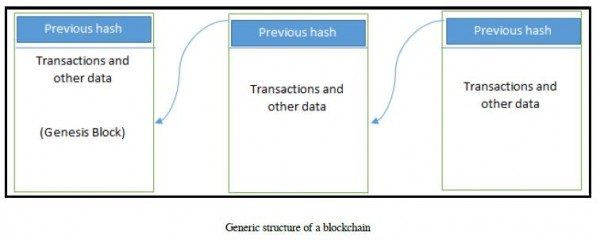Blockchain – Trust through Technology
At least since November 2017, when Bitcoin and other crypto currencies exploded in value, blockchain has become a widely used term. Blockchain, however, is not only the backbone of crypto currencies, but also a useful technology that can serve applications in many different industries.
Why Blockchain?
To understand what blockchain is, one has to go back to the reasons for its invention: In our daily life, we often encounter “trusted third parties”. A good example for a trusted third party is a bank. When someone wants to pay with their credit card in a pizzeria, for example, they must prove that they have enough money in their account to make the payment. To ensure this, the pizzeria sends a query to the bank, and if the bank verifies the credit card, money is sent from the customer’s account to the pizzeria. Both the customer and the pizzeria have to trust the bank in this scheme, which is why the bank is called the trusted third party. More examples for trusted third parties are electricity companies, ticket systems, or the land registry office.
In computer science, the pizzeria example refers to a centralized system. This means that there is one single entity, the bank, which decides on the validity of transactions. The problem is that these centralized systems usually require payment for their services.
A blockchain, on the other hand, is a decentralized system. Instead of one centralized entity in a network, the blockchain consists of many, equal entities managing transactions. These entities are called nodes. To confirm the validity of a transaction in a blockchain, it has to be verified by multiple nodes. Nonetheless, the validation of transactions is typically cheaper than in a centralized system, which is one reason why the technology was invented.
What is a Blockchain?
A blockchain can roughly be described as a network in which multiple nodes can exchange data on transactions without having to be connected to a centralized entity for validation. All transactions are saved to blocks. As the name implies, these blocks are then connected to one another into a chain. The size of the blocks and the details of their connection differ between different implementations of the blockchain.
When a blockchain is first created, an initial “genesis block” is generated. This block contains no transactions, but it serves as the anchor to which other blocks can be connected. All following blocks either contain a reference to the genesis block, or to any other block in the blockchain. In addition to this reference, all blocks contain some transactions and the “nonce”. The nonce is a value of a given length, which is essential to the function of the chain. The references are created using hashes. Hashes are, in essence, a string of symbols generated by a special mathematical function. A single block has the following composition:

From which the following structure of the chain is derived:

The field “previous hash” serves as the reference to previous blocks and it represents their content through a cryptic string of characters. Without access to the block it is pointing to, the previous hash field makes it virtually impossible to derive the content of other blocks. Only with a perfect copy of the data in the previous block, the previous hash field of the next block can be reconstructed. This feature of the blockchain, the mathematical hashing of data, ensures that nobody can change the content of previous blocks without affecting the entire blockchain.
How does a blockchain work?
As soon as the genesis block and with it the entire blockchain has been created, users (nodes in the network) can start creating transactions. As soon as a transaction has been created, it is sent to all the other nodes in the network. Afterwards, the transaction has to be validated by several nodes in the network. The exact design of this validation is subject to the specific implementation of a blockchain. As soon as a sufficient number of chains have validated a transaction, it is added to a block, which is in turn added to the blockchain. The next block that is created will then take the data on transactions from the previous block and create a hash from said data. Thereby, the previous block and the included transactions a validated. Every time a new block is created, it automatically validates previous blocks, while the blockchain continues to grow.
Conclusion
Blockchain is a technology which is intended to reduce the cost and effort of trusted third parties by using a decentralized system of nodes, which can exchange data in the form of transactions. Trust is ensured via mathematical functions and clever validation methods.
The most widely known implementation of blockchain technology is currently Bitcoin. However, all other crypto currencies also use blockchain in their systems.
Blockchain is a technology which will see usage in many different industries, with intensive research still going into its further development. Like most technologies, blockchain comes with its own challenges in terms of scaling, adaptability, and privacy.
Sources
Imran Bashir. 2017. Mastering Blockchain. Birmingham, United Kingdom: Packt Publishing Ltd.
Jobs available!
We are looking for a working student as Deputy Support Coordinator (50-60%). You can find more details about the position here. Apply now or share the job description with your friends!
Order Information
You can track the order status of your laptop in our distribution partner's customer account. You can find information on this in the FAQ.
Help Point : Please book an appointment
Our support staff at the Help Points ETHZ, Bern vonRoll, UNIBAS and UNILU are there for you. If you need technical support, contact us via email to make an appointment.
Jobs available!
We are looking for a working student as Deputy Support Coordinator (50-60%). You can find more details about the position here. Apply now or share the job description with your friends!
Order Information
You can track the order status of your laptop in our distribution partner's customer account. You can find information on this in the FAQ.
Help Point : Please book an appointment
Our support staff at the Help Points ETHZ, Bern vonRoll, UNIBAS and UNILU are there for you. If you need technical support, contact us via email to make an appointment.
